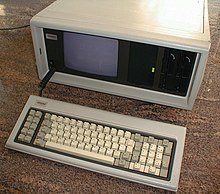Many commercial and government field forces deploy a ruggedized portable computer such as the Panasonic Toughbook or larger rack-mounted computers with their fleet of vehicles. This requires the units to be anchored to the vehicle for driver safety, device security, and user ergonomics. Ruggedized computers are rated for severe vibration associated with large service vehicles and off-road driving, and the harsh environmental conditions of constant professional use such as in emergency medical services, fire and public safety.

The Compaq Portable
- Operating temperature: A vehicle cabin can often experience temperature swings from -20F to +140F. Computers typically must be able to withstand these temperatures while operating. Typical fan based cooling has stated limits of 95F-100F of ambient temperature, and temperature below freezing require localized heaters to bring components up to operating temperature(based on independent studies by the SRI Group and by Panasonic R&D).
- Vibration: Vehicles typically have considerable vibration that can decrease life expectancy of computer components, notably rotational storage such as HDDs.
- Daylight, or sunlight readability: Visibility of standard screens becomes an issue in bright sunlight.
- Touchscreens: These enable users to easily interact with the units in the field without removing gloves.
- High-temperature battery settings:. Lithium ion batteries are sensitive to high temperature conditions for charging. A computer designed for the mobile environment should be designed with a high-temperature charging function that limits the charge to 85% or less of capacity.
- External wireless connections, and external GPS antenna connections: Necessary to contend with the typical metal cabins of vehicles and their impact on wireless reception, and to take advantage of much more capable external tranception equipment.
Specialized installation companies specialize in designing the mount design, assembling the parts, and installing them in a safe and consistent manner away from airbags, vehicle HVAC controls, and driver controls. Frequently installations will include a WWAN modem, power conditioning equipment, and WWAN/WLAN/GPS/etc. transceiver antennæ mounted external to the vehicle. Mobile internet access is generally slower than direct cable connections, using technologies such as general packet radio service (GPRS) and Enhanced Data for GSM Evolution (EDGE), and more recently 3G networks. These networks are usually available within range of commercial cell phone towers. Higher speed wireless LANs are inexpensive, but have very limited range


 5:20 AM
5:20 AM
 Computer
Computer
0 comments:
Post a Comment